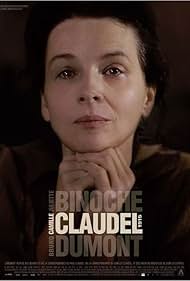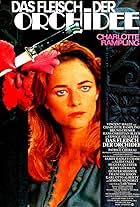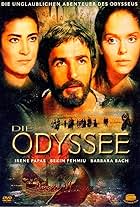IMDb-BEWERTUNG
6,5/10
4010
IHRE BEWERTUNG
Füge eine Handlung in deiner Sprache hinzuWinter, 1915. Confined by her family to an asylum in the South of France - where she will never sculpt again - the chronicle of Camille Claudel's reclusive life, as she waits for a visit fro... Alles lesenWinter, 1915. Confined by her family to an asylum in the South of France - where she will never sculpt again - the chronicle of Camille Claudel's reclusive life, as she waits for a visit from her brother, Paul Claudel.Winter, 1915. Confined by her family to an asylum in the South of France - where she will never sculpt again - the chronicle of Camille Claudel's reclusive life, as she waits for a visit from her brother, Paul Claudel.
- Auszeichnungen
- 4 Gewinne & 5 Nominierungen insgesamt
Jessica Errero
- Nursing Home Resident
- (as Jessica Herrero)
Handlung
WUSSTEST DU SCHON:
- WissenswertesThe French culture magazine 'Transfuge' named Camille Claudel 1915 (2013) the No.1 film of 2013.
- Crazy CreditsLoosely inspired by the works and correspondence of Paul Claudel and correspondence of Camille Claudel.
- VerbindungenReferenced in "Ein Gespräch mit..." (2018)
Ausgewählte Rezension
"There is something sadder to lose than life – the reason for living." Paul Claudel, poet, playwright, diplomat and younger brother of Camille.
Camille Claudel 1915 is not The King of Hearts, a lyrical 1966 drama about a WWII French asylum in a town about to be invaded by Nazis. Claudel is decidedly not lyrical except for its exceptionally artistic cinematography dominated by trees that look like sculptures and buildings ancient with secrets.
It's a somber but fascinating three-day narrative about artist Camille Claudel's confinement in a madhouse while she is awaiting her famous mystic-poet brother, Paul, to visit her.
Previous to 1915, Camille had been the student and lover of Auguste Rodin, the most famous French sculptor of his time and one of the greatest in the history of civilization. Her incarceration was due to her paranoia in general about his alleged plot to poison her and her schizophrenia, both reflected after breaking up with Rodin in her smashing her sculptures in her own studio.
This film deals little with Rodin but much with her brother, who refused her entreaties, and those of the mental hospital staff, to release her. His chilling visitation to her is redolent of his reliance on a mystical relation with God and certainty that she not be released to go home. The introductory quote suggests he may not have adhered to his own philosophy by ignoring the signs that she was sane and the reality of denying her a reason to live.
This stark film concentrates mostly on her lonely struggle to protect herself from the plot to poison her and her loss of her sculptures and tools. Her artistry is supplanted by boiling potatoes and avoiding crazed fellow inmates. She says in one of her letters, "Madhouses are houses made on purpose to cause suffering .I cannot stand any longer the screams of these creatures." The movie is static but intensely suggestive through the brilliant Binoche's expressions of wisdom and isolation.
It's not hard to sympathize with an artist robbed of her livelihood and family. That she may truly be schizophrenic and paranoid is always possible; however Binoche's humanity tips the scale in favor of Camille's sanity and the world's indifference. As a woman and an artist in the shadow of Rodin, she is doomed to second-class citizenship.
Camille will spend almost three decades without hope: "Sadder than to lose one's possessions is to lose one's hope." Paul Claudel
Camille Claudel 1915 is not The King of Hearts, a lyrical 1966 drama about a WWII French asylum in a town about to be invaded by Nazis. Claudel is decidedly not lyrical except for its exceptionally artistic cinematography dominated by trees that look like sculptures and buildings ancient with secrets.
It's a somber but fascinating three-day narrative about artist Camille Claudel's confinement in a madhouse while she is awaiting her famous mystic-poet brother, Paul, to visit her.
Previous to 1915, Camille had been the student and lover of Auguste Rodin, the most famous French sculptor of his time and one of the greatest in the history of civilization. Her incarceration was due to her paranoia in general about his alleged plot to poison her and her schizophrenia, both reflected after breaking up with Rodin in her smashing her sculptures in her own studio.
This film deals little with Rodin but much with her brother, who refused her entreaties, and those of the mental hospital staff, to release her. His chilling visitation to her is redolent of his reliance on a mystical relation with God and certainty that she not be released to go home. The introductory quote suggests he may not have adhered to his own philosophy by ignoring the signs that she was sane and the reality of denying her a reason to live.
This stark film concentrates mostly on her lonely struggle to protect herself from the plot to poison her and her loss of her sculptures and tools. Her artistry is supplanted by boiling potatoes and avoiding crazed fellow inmates. She says in one of her letters, "Madhouses are houses made on purpose to cause suffering .I cannot stand any longer the screams of these creatures." The movie is static but intensely suggestive through the brilliant Binoche's expressions of wisdom and isolation.
It's not hard to sympathize with an artist robbed of her livelihood and family. That she may truly be schizophrenic and paranoid is always possible; however Binoche's humanity tips the scale in favor of Camille's sanity and the world's indifference. As a woman and an artist in the shadow of Rodin, she is doomed to second-class citizenship.
Camille will spend almost three decades without hope: "Sadder than to lose one's possessions is to lose one's hope." Paul Claudel
- JohnDeSando
- 24. Jan. 2014
- Permalink
Top-Auswahl
Melde dich zum Bewerten an und greife auf die Watchlist für personalisierte Empfehlungen zu.
- How long is Camille Claudel 1915?Powered by Alexa
Details
- Erscheinungsdatum
- Herkunftsland
- Offizielle Standorte
- Sprache
- Auch bekannt als
- Камілла Клодель, 1915
- Drehorte
- Produktionsfirmen
- Weitere beteiligte Unternehmen bei IMDbPro anzeigen
Box Office
- Budget
- 3.200.000 € (geschätzt)
- Bruttoertrag in den USA und Kanada
- 35.296 $
- Eröffnungswochenende in den USA und in Kanada
- 5.106 $
- 20. Okt. 2013
- Weltweiter Bruttoertrag
- 660.355 $
- Laufzeit1 Stunde 35 Minuten
- Farbe
- Sound-Mix
- Seitenverhältnis
- 2.35 : 1
Zu dieser Seite beitragen
Bearbeitung vorschlagen oder fehlenden Inhalt hinzufügen

Oberste Lücke
By what name was Camille Claudel 1915 (2013) officially released in India in English?
Antwort
























